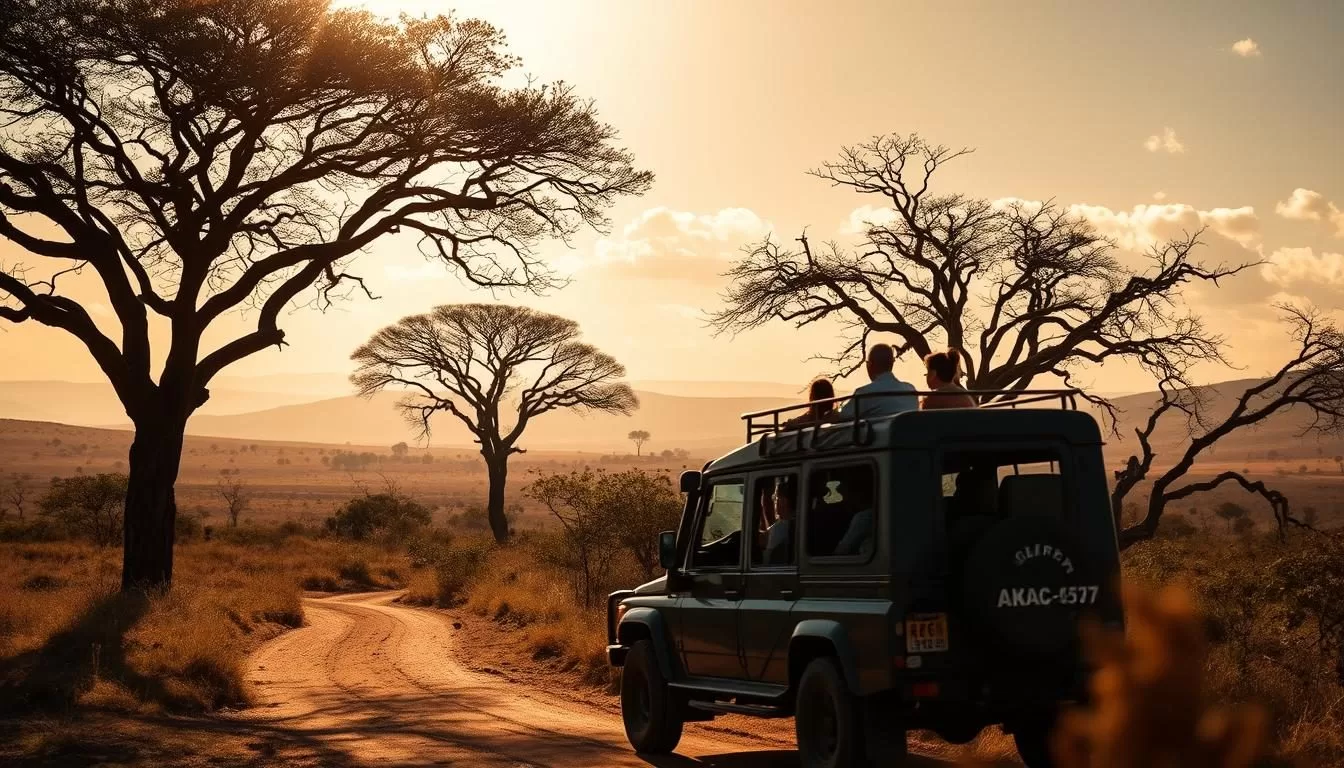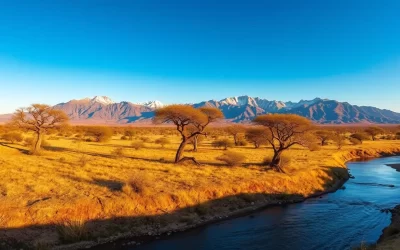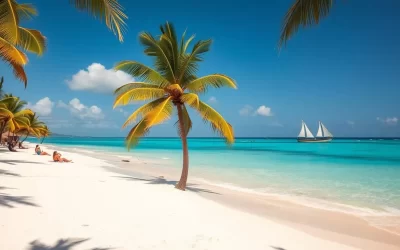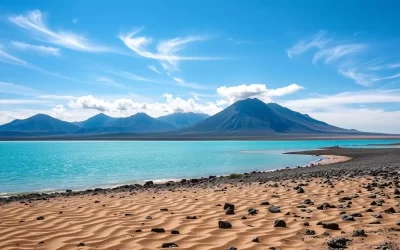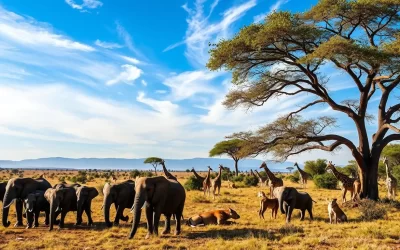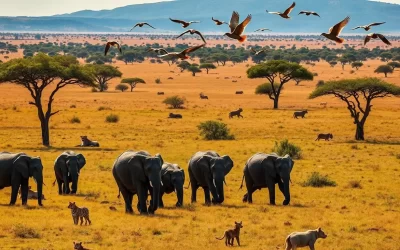✓ Accommodations ✓ Flights ✓ Rental Cars
Located on the northeastern shores of Lake Turkana, Sibiloi National Park is a historically significant destination that is often overlooked by travelers. As a UNESCO World Heritage site, it is renowned for its remarkable fossil discoveries, earning it the nickname “Cradle of Mankind.”
This unique safari destination offers a blend of archaeological sites, wildlife viewing opportunities, and cultural experiences. The park’s distinctive desert landscape provides a striking backdrop for your travel adventures.
As you plan your journey to this remote Kenyan treasure, our comprehensive guide will help you navigate the tours and activities that make Sibiloi a must-visit destination. With its authentic experiences and untouched beauty, Sibiloi offers a truly unforgettable travel experience.
Discovering Sibiloi National Park: Kenya’s Hidden Gem
As you explore Sibiloi National Park in Kenya, you’ll uncover the secrets of human evolution and prehistoric life. This national park, though lesser-known, is a treasure trove of historical significance and natural beauty, making it a fascinating destination for anyone interested in paleontology and the ancient world.
The UNESCO World Heritage Status
Sibiloi National Park’s significance was recognized globally when it was designated a UNESCO World Heritage Site. This prestigious status acknowledges the park’s unique cultural and natural heritage, highlighting its importance in understanding human history and the Earth’s past.
The park’s rich fossil heritage is a key factor in its UNESCO recognition. The discovery of a 2-million-year-old skull labeled “1470” by Dr. Richard Leakey in 1972 was a groundbreaking moment, confirming the existence of Homo habilis and Homo erectus. This find underscored the park’s role in human evolution studies.
| Fossil Discovery | Age | Significance |
|---|---|---|
| Giant Tortoise Remains | 3 million years | Provides insights into prehistoric life |
| Ancient Crocodile Fossils | 2 million years | Highlights the evolution of species |
| “Behemoth” Fossils | 1.5 million years | Evidence of ancient fauna |
The Cradle of Mankind: Historical Significance
Sibiloi National Park is often referred to as the “Cradle of Mankind” due to its pivotal role in understanding human evolution. The park’s fossil remains, including those of Australopithecus and early Homo species, have significantly contributed to our knowledge of human ancestry.
The park’s historical significance extends beyond its fossils. The remains of ancient species found here, such as giant tortoises and crocodiles, provide a glimpse into the region’s prehistoric past. Visitors can explore these fossils and remains through guided tours, connecting with the area’s rich history.
The nickname “Cradle of Mankind” is a testament to Sibiloi’s importance in the field of paleoanthropology. With millions of years of history preserved within its boundaries, the park attracts researchers and history enthusiasts from around the globe. As you visit Sibiloi, you’ll be walking in the footsteps of our ancient ancestors, gaining a deeper understanding of human evolution and the natural world.
Location and Geography of Sibiloi National Park
Sibiloi National Park, located on the southeastern shore of Lake Turkana, is a unique blend of geological wonders and archaeological sites. The park’s geography is characterized by its proximity to the lake and its position within the Great Rift Valley, a region known for its significant geological and paleontological importance.
Lake Turkana: The Jade Sea
Lake Turkana, also known as the “Jade Sea” due to its striking water color, is a dominant feature of the region. The lake’s presence has a profound effect on the local ecosystem, creating a variety of habitats that support a wide range of flora and fauna. The lake’s shoreline and surrounding areas are crucial for understanding the geological history of the region, with sedimentary deposits providing valuable insights into the past.
The lake’s influence on the local climate and geography is significant, with its waters supporting a diverse array of aquatic life. The surrounding landscape, shaped by the lake’s presence, offers a unique environment that is both harsh and beautiful.
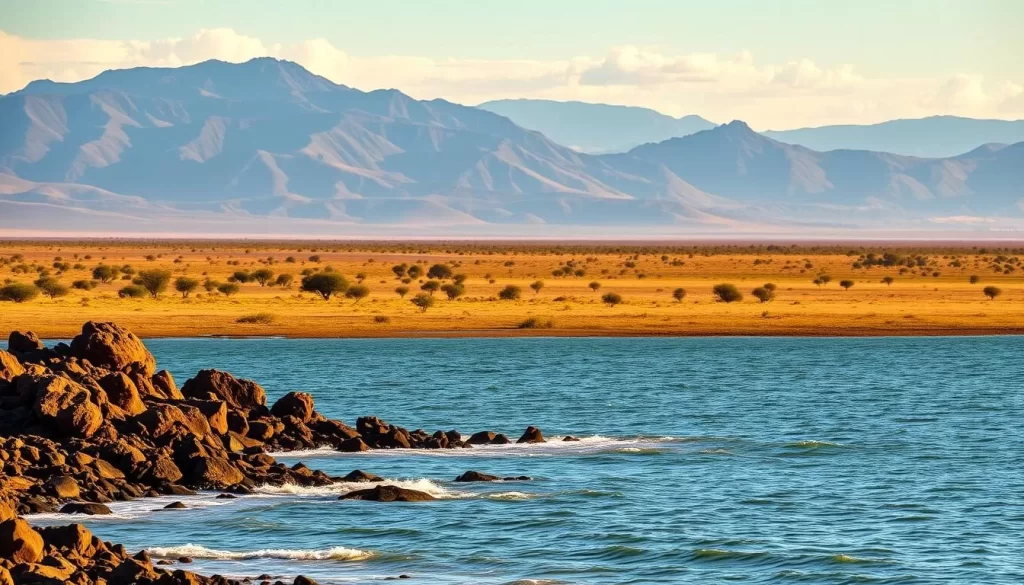
Landscape and Terrain Features
The terrain of Sibiloi National Park is diverse, ranging from semi-arid desert landscapes to volcanic formations and lakeshore environments. This diversity creates distinct ecological zones, each with its unique characteristics and inhabitants. The park’s geological features, including sedimentary deposits, have made it an ideal location for preserving fossils and prehistoric artifacts.
The landscape is dotted with commiphora woodlands, euphorbias, and the striking desert rose (Adenium obesum), flora that have adapted to the harsh conditions. The remains of a petrified forest around Mount Sibiloi provide evidence of the region’s complex geological history, with cedar forests having covered the lakeshore approximately 7 million years ago.
| Terrain Feature | Description | Ecological Significance |
|---|---|---|
| Semi-arid Desert Landscapes | Characterized by sparse vegetation and limited rainfall. | Supports unique and adapted flora and fauna. |
| Volcanic Formations | Resulting from geological activity in the Rift Valley. | Creates diverse habitats and influences local climate conditions. |
| Lakeshore Environments | Areas surrounding Lake Turkana, influenced by its waters. | Supports a wide range of aquatic and terrestrial life. |
The Great Rift Valley’s geological activity has played a crucial role in shaping the current landscape of Sibiloi National Park, contributing to the preservation of its remarkable fossil record. The changing terrain influences wildlife distribution, creating diverse habitats despite the generally arid conditions. As you explore the park, you’ll witness the intricate relationship between the geography and the life it supports.
How to Get to Sibiloi National Park
For those looking to explore one of Kenya’s most hidden gems, understanding how to get to Sibiloi National Park is the first step.

By Road: Routes and Transportation Options
Traveling to Sibiloi National Park by road is a popular option, offering scenic views along the way. The most common route is from Nairobi, taking the A2 highway northwards towards Marsabit, then continuing to the park’s entrance. Visitors can use either private vehicles or opt for guided tours that include transportation.
The condition of the roads can vary, so it’s advisable to check the current state before embarking on your journey and to consider using a 4WD vehicle for better navigation.
By Air: Available Airstrips and Flights
For those preferring a faster mode of transport, flying to Sibiloi National Park is an option. The nearest airstrips are in Loiyangalani and Eliye Springs, which receive charter flights from Nairobi or other major Kenyan cities. From these airstrips, visitors can arrange for road transfers to the park.
It’s essential to book flights in advance, especially during peak travel seasons, to ensure availability.
Park Gates and Entry Points
Sibiloi Park has multiple entry points, with the Karsa gate being the main entrance. Other gates include Koobi Fora and Alia Bay, catering to visitors from different directions.
- Karsa Gate: The primary entry point, open throughout the day, with ranger stations and information centers available.
- Koobi Fora Gate: Suitable for those visiting the Koobi Fora Museum, with limited hours of operation.
- Alia Bay Gate: Ideal for visitors coming from the southern parts of Lake Turkana, operating during daylight hours.
Visitors are advised to check the operating hours and any specific requirements for each gate before their visit to ensure a smooth entry into the park.
Using a guide can enhance your experience, providing insights into the park’s history, geology, and wildlife.
Best Time to Visit Sibiloi National Park
Sibiloi National Park, a hidden gem in Kenya, offers varying experiences throughout the year, making the timing of your visit critical. The park’s diverse climate and rich wildlife mean that different times of the year are better suited for different activities and viewing experiences.
Seasonal Weather Patterns
The climate in Sibiloi National Park is characterized by dry and wet seasons, significantly impacting the time visit for optimal experiences. The dry seasons, from June to September and December to February, are generally considered the best periods for visiting, as the dry conditions concentrate wildlife around Lake Turkana and other water sources.
During these dry periods, the weather is hot and dry, making it ideal for spotting animals that gather at the lake and other remaining water bodies. The dry seasons also facilitate easier navigation through the park’s terrain.
Wildlife Viewing Seasons
The wildlife in Sibiloi National Park is incredibly diverse, with various species present throughout the year. The dry seasons are optimal for viewing terrestrial wildlife, including Burchell’s and Grevy’s zebras, topi, kudu, leopard, and cheetah, as they congregate around water sources.
March is a particularly exciting time to visit, as it coincides with the Nile crocodile breeding season. With an estimated 12,000 crocodiles, Sibiloi hosts one of the world’s largest crocodile populations, offering a unique viewing opportunity.
The park is also a haven for birdwatchers, with various migratory bird species passing through at different times of the year. Additionally, Lake Turkana is home to over 60 fish species, providing a rich environment for fishing and aquatic life observation throughout the year.
Understanding the seasonal patterns and time visit preferences for different activities can significantly enhance your experience at Sibiloi National Park, allowing you to plan your trip during the optimal time visit for your interests.
Entrance Fees and Park Regulations
To ensure a hassle-free visit to Sibiloi National Park, familiarize yourself with the entrance fees and regulations. Understanding these guidelines will enhance your overall safari experience and help preserve the park’s natural beauty.
Ticket Prices for Different Visitor Categories
Sibiloi National Park has a tiered pricing system based on the visitor’s nationality. For East African Community (EAC) citizens, the entrance fee is KES 300 for adults and KES 250 for children. Visitors from the rest of Africa are charged USD 20 for adults and USD 15 for children. International visitors pay USD 25 for adults and USD 15 for children. It’s essential to have the correct currency for a smooth entry process.
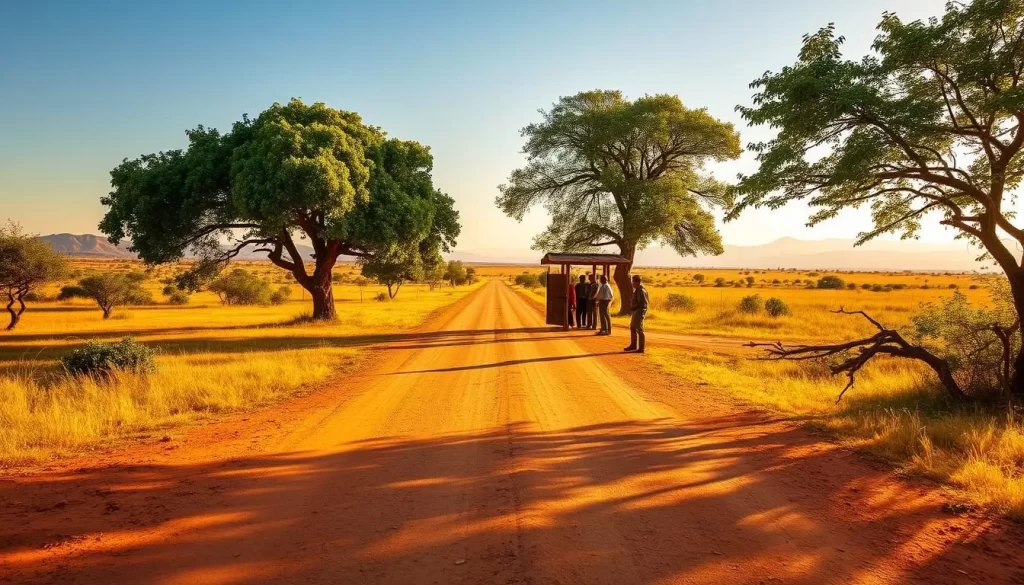
Important Rules and Guidelines
To ensure a safe and enjoyable visit, adhere to the park’s regulations. Here are some key guidelines:
- Maintain a safe distance from wildlife and refrain from disturbing animals to ensure both your safety and theirs.
- Archaeological sites within the park are protected; removing fossils, artifacts, or other items is strictly prohibited.
- Vehicle regulations include adhering to speed limits, driving only on designated paths, and avoiding off-road driving to protect the fragile ecosystem.
- Practice the “pack it in, pack it out” principle, especially important in this remote area with limited facilities.
- For photography, especially commercial shoots, obtain the necessary permits and be mindful of restrictions around sensitive areas.
- If camping, follow fire safety guidelines, use designated camping areas, and respect noise restrictions to maintain the serene environment.
By following these guidelines, you’ll not only have a great safari but also contribute to preserving Sibiloi National Park’s unique environment and historical sites, making your visit a positive experience for both you and future visitors.
Top Archaeological Sites in Sibiloi National Park
Sibiloi National Park, a treasure trove of archaeological findings, offers a glimpse into the past through its various sites and museums. The park’s rich heritage is a result of its unique geological features, which have created ideal conditions for fossil preservation.
Koobi Fora Museum and Research Base
The Koobi Fora Museum and Research Base is a pivotal site for understanding human evolution. As a world heritage site, it houses a vast collection of fossils and artifacts that have been crucial in shaping our understanding of human ancestry. Visitors can explore the museum to gain insights into the region’s prehistoric past.
The research base is actively involved in ongoing research and excavations, providing a unique opportunity for visitors to witness the process of discovery firsthand. The fossils of a 3-million-year-old giant tortoise and other ancient species are among the many remarkable finds that have been uncovered in the area.
Fossil Beds and Prehistoric Discoveries
The fossil beds within Sibiloi National Park are renowned for their significant contributions to paleontology and human evolutionary studies. The area is known for its rich deposits of fossils, including those of an ancient crocodile species and the 1.5-million-year-old ‘Behemoth’. These discoveries have been pivotal in understanding the evolutionary history of various species.
The remains found in the park, including remains of Australopithecus and early Homo fossils, have significantly advanced our understanding of human evolution. Guided tours are available, allowing visitors to explore these fossil beds with knowledgeable guides who can interpret the landscape and its prehistoric treasures.
- The major fossil beds within the park and their significance to paleontology and human evolutionary studies.
- Spectacular discoveries, including the 3-million-year-old giant tortoise remains, ancient crocodile fossils, and the 1.5-million-year-old “Behemoth.”
- The significance of the Australopithecus and early Homo fossils found in the region.
Wildlife Viewing at Sibiloi National Park
As you explore Sibiloi National Park, you’ll encounter a vast array of wildlife adapted to the harsh semi-desert environment. The park’s unique landscape and the presence of Lake Turkana create a diverse habitat that supports a wide range of species.
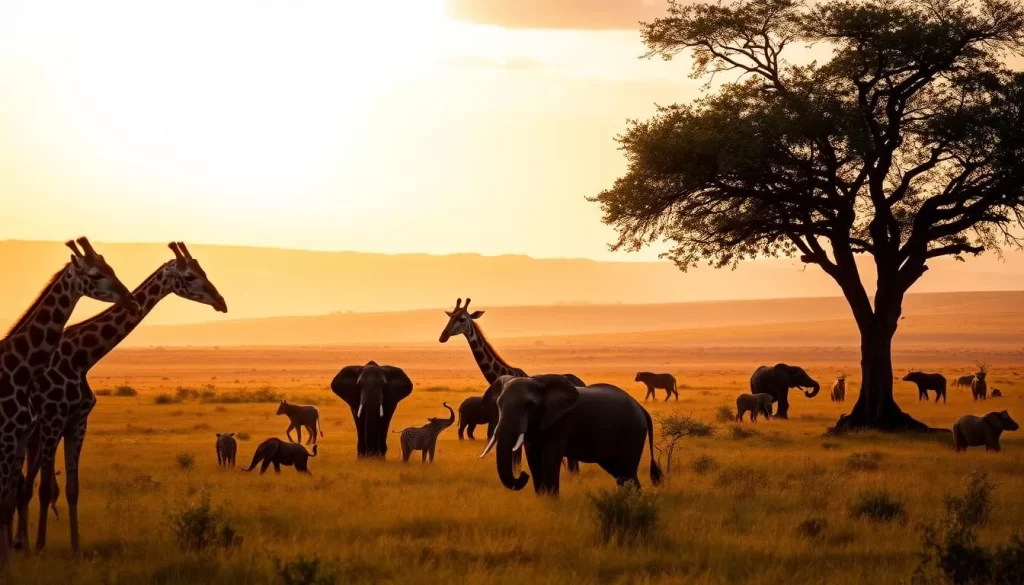
Mammals and Land Animals
Sibiloi National Park is home to a variety of mammals and land animals. The park’s terrain supports a range of herbivores and carnivores, each adapted to the challenging conditions. Some of the notable mammals include:
- Lions
- Leopards
- Cheetahs
- Elephants
- Giraffes
These animals have adapted to the park’s semi-desert conditions, with some migrating to areas with water sources during dry seasons.
The Crocodile Kingdom of Lake Turkana
Lake Turkana is known for its large population of Nile crocodiles, making it a significant location for these reptiles. The lake‘s water provides a suitable environment for crocodiles, and they can be seen basking on the shores or swimming in the lake.
The presence of crocodiles in Lake Turkana is a highlight for many visitors, offering a unique opportunity to observe these ancient creatures in their natural habitat.
Reptiles and Other Species
Sibiloi National Park is also home to a diverse range of reptiles, including venomous snakes such as the night adder, puff adder, cobra, and saw-scaled viper. Visitors should be cautious and aware of their surroundings to avoid encounters with these dangerous species.
In addition to snakes, the park is inhabited by various lizard species, from small geckos to larger monitor lizards. These reptiles play crucial ecological roles, contributing to the balance of the ecosystem.
The lake is also home to a variety of fish species, including the commercially important Nile perch and tilapia. The presence of puffer fish in Lake Turkana suggests a historical connection to the Red Sea, highlighting the lake‘s unique ecological significance.
Other notable invertebrate species in the park include scorpions, spiders, and various insect species that are adapted to the arid environment and play vital ecological roles.
Birdwatching Opportunities
The unique landscape of Sibiloi National Park attracts a wide variety of birdlife, making it a paradise for birdwatchers. With its diverse habitats, including the vast waters of Lake Turkana, the park supports a rich avifauna that is a delight to explore.
Resident Bird Species
Sibiloi National Park is home to a significant number of resident bird species. The park’s diverse habitats, from the lake’s shoreline to the surrounding landscapes, support a wide range of birds that can be observed throughout the year. Among the resident species, some are particularly noteworthy for their unique characteristics or behaviors.
The park’s water bodies, especially Lake Turkana, are home to approximately 84 recorded water bird species. These include various types of herons, egrets, and other waterfowl that are attracted to the lake’s rich aquatic life. The presence of these birds not only adds to the park’s biodiversity but also offers birdwatchers a chance to observe a variety of species in their natural habitats.
Migratory Birds and Seasonal Sightings
Sibiloi National Park is not only a haven for resident birds but also a critical stopover for many migratory species. The park’s location along the flyway for Palearctic migrants makes it an essential site for birds traveling between Europe, Asia, and Africa. During certain seasons, particularly the European spring migration period (March-April), the park hosts a spectacular array of migratory birds.
The congregations of certain species, such as flamingos, create spectacular viewing opportunities. These gatherings are not only a treat for birdwatchers but also underscore the park’s importance as a conservation area. However, it’s worth noting that climate change and habitat loss are affecting migratory patterns, making protected areas like Sibiloi increasingly crucial for the survival of these vulnerable species.
Embarking on a safari or safaris in Sibiloi National Park offers a unique chance to witness the rich birdlife, including both resident and migratory species. The experience is enhanced by the park’s serene landscapes and the opportunity to observe birds in their natural environments, often near the water bodies that are so vital to their survival.
Sibiloi National Park, Kenya: Best Things to Do – Top Picks
Experience the best of Kenya’s wilderness at Sibiloi National Park, where a diverse range of activities awaits you. From archaeological safaris to breathtaking boat safaris on Lake Turkana, this park is a treasure trove of adventure and cultural experiences. As you plan your tour Kenya, Sibiloi National Park should be at the top of your list.
Archaeological Safaris and Fossil Hunting
Embark on an experience of a lifetime with archaeological safaris in Sibiloi National Park. The park is renowned for its rich fossil beds and archaeological sites, offering a unique glimpse into human history. You can explore the Koobi Fora Museum and Research Base, where numerous significant discoveries have been made, including the famous “Hominin” fossils. Fossil hunting, guided by expert paleontologists, allows you to uncover the secrets of the region’s prehistoric past.
Boat Safaris on Lake Turkana
A boat safari on Lake Turkana is an unforgettable activity that lets you get up close to the park’s incredible wildlife. The lake is home to a vast array of crocodiles, making it one of the world’s largest crocodile habitats. You can also spot hippos, various bird species, and other aquatic life. The serene waters of Lake Turkana offer a tranquil setting for a safari experience unlike any other.
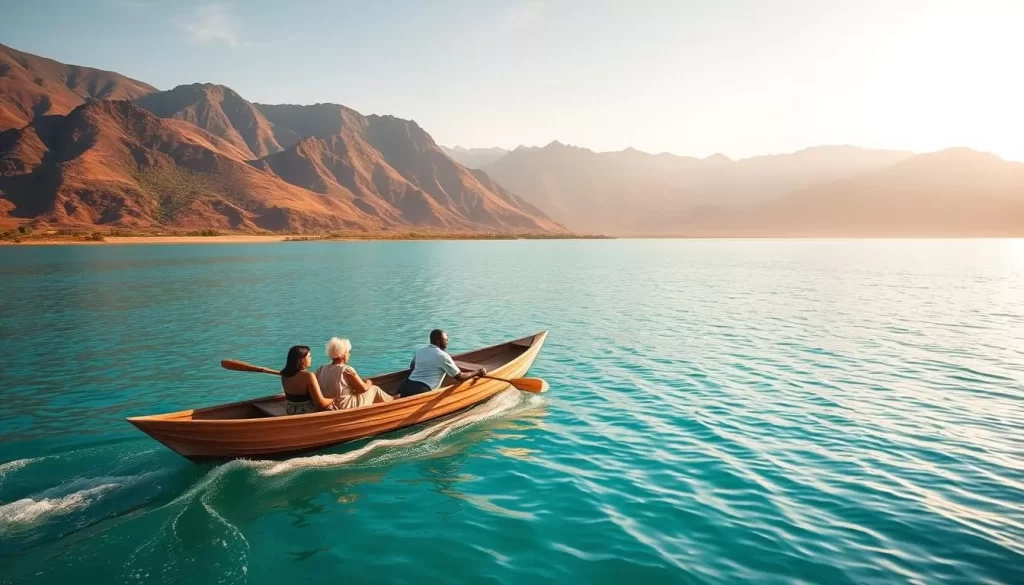
Game Drives and Wildlife Photography
Game drives are a thrilling way to explore Sibiloi National Park’s diverse wildlife. The park is home to a wide range of mammals, including elephants, lions, and giraffes. As you venture through the park’s rugged terrain, you’ll have ample opportunities for wildlife photography. The unique landscape and harsh environment have adapted various species, making every sighting a remarkable experience.
Cultural Visits to Local Communities
Engaging in cultural visits to local communities is a meaningful way to enrich your visit to Sibiloi National Park. The indigenous communities, including the El Molo, Turkana, and Dassanech peoples, have developed unique cultural practices over generations. You can participate in traditional dance performances, witness demonstrations of fishing techniques, and observe craft making. These interactions not only provide a deeper understanding of the region’s human history but also support local communities through sustainable tourism practices.
When arranging community visits, it’s essential to work with local guides who serve as cultural interpreters. They ensure that interactions are respectful and beneficial to the community. By engaging in these cultural activities, you contribute to the preservation of local traditions and the economic well-being of the communities.
Mount Sibiloi and the Petrified Forest
The volcanic Mount Sibiloi in Sibiloi National Park holds a significant secret: the petrified remains of a cedar forest that dates back millions of years. This natural wonder provides a unique glimpse into the region’s geological past.
Hiking Opportunities
Visitors to Sibiloi National Park can explore Mount Sibiloi through various hiking trails. These trails not only offer breathtaking views of Lake Turkana but also provide an opportunity to witness the petrified forest up close. The hike to the petrified forest is a journey through time, with the remains of ancient trees serving as a testament to the region’s transformation over 7 million years.
The trails are designed to cater to different levels of hikers, ensuring that everyone can experience the beauty and significance of Mount Sibiloi. As you hike, you’ll be surrounded by the stark yet beautiful landscape, with the petrified trees standing as sentinels of the past.
Ancient Cedar Forest Remains
The petrified forest at Mount Sibiloi is a remarkable site, with the remains of cedar trees preserved in remarkable detail. The process of petrification transformed these ancient trees into stone, retaining their cellular structure and allowing scientists to identify them as cedar. This discovery has been crucial in reconstructing the paleoenvironment of the region, indicating a much wetter climate in the distant past.
Visitors can observe the petrified trees, some of which are quite large, and note their preservation quality and location within the park. These fossilized remains are not only a testament to the region’s geological history but also relate to other fossil discoveries in the area, including remains of animals that would have inhabited these ancient forests. It’s essential for visitors to follow park guidelines to preserve these exposed fossil sites for future generations.
Fishing in Lake Turkana
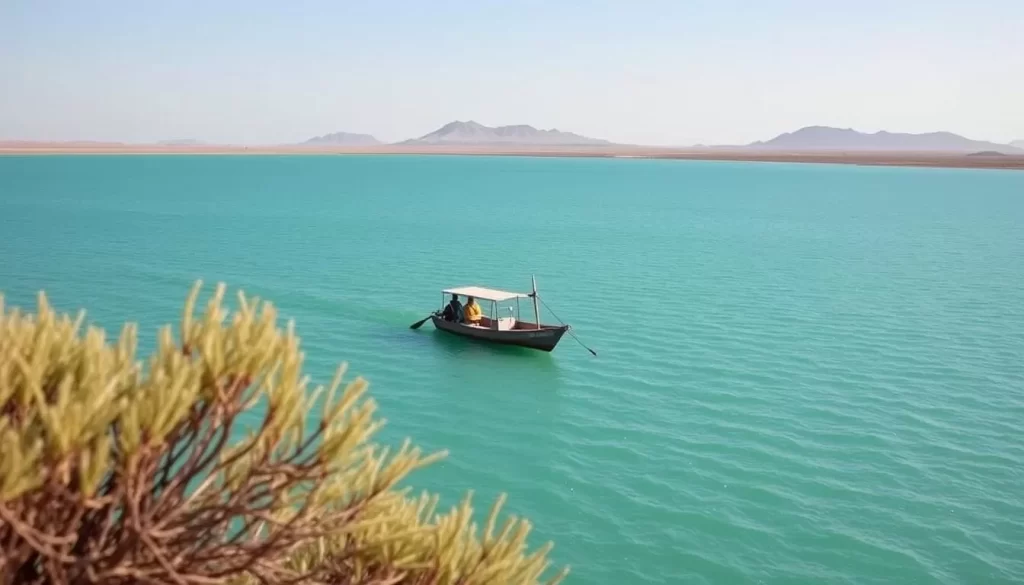
Lake Turkana, known for its rich biodiversity, offers an exceptional fishing experience. The lake is home to a variety of fish species, making it a paradise for anglers.
Popular Fish Species
The lake’s waters are inhabited by species such as Nile Perch and Large Tilapia, making it a diverse fishing ground. The presence of Puffer Fish also indicates the lake’s unique connection to the Red Sea.
These species not only provide a thrilling experience for fishermen but also contribute to the lake’s ecosystem. Understanding the types of fish and their habitats is crucial for a successful safari or fishing tour.
Fishing Regulations and Equipment
To ensure the sustainability of Lake Turkana’s fish resources, the park has implemented several fishing regulations. Visitors are required to obtain a permit before engaging in fishing activities. The permit process involves understanding catch limits, size restrictions, and seasonal regulations.
For a successful fishing experience, using the right equipment is essential. The lake’s diverse species require different tackle. Hiring a local guide can be beneficial, as they provide both the necessary equipment and knowledge about the best fishing locations and techniques.
It’s also important to follow ethical fishing practices, such as catch-and-release for certain species and proper handling to minimize stress on the fish. This ensures that the fishing experience is sustainable for future visitors.
Accommodation Options at Sibiloi National Park
Sibiloi National Park offers a range of accommodation options to suit different preferences and budgets.
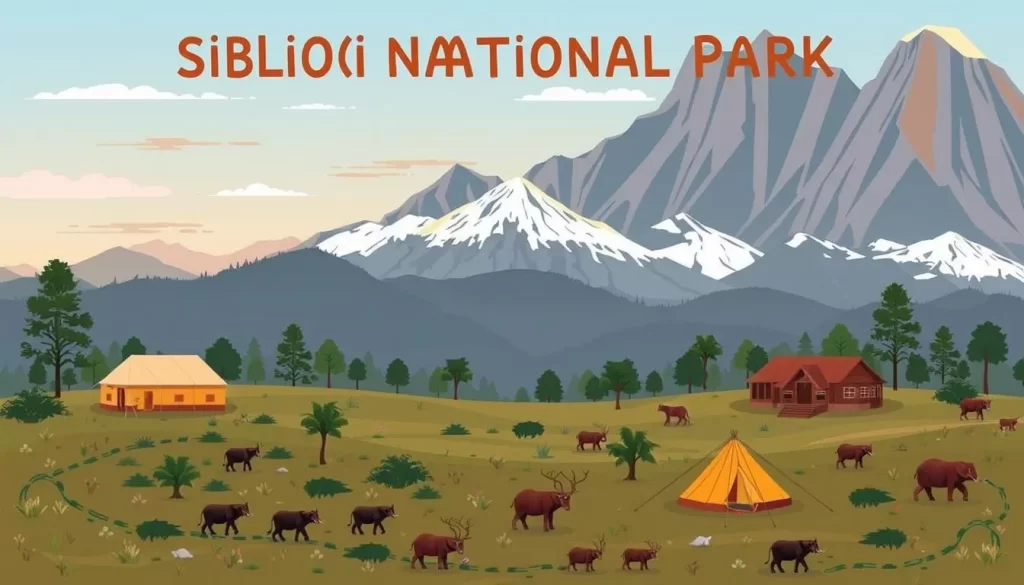
Lodges and Tented Camps
For those seeking comfort, Sibiloi National Park has lodges and tented camps that provide a unique blend of luxury and wilderness experience. The Sunset Strip Camp is one such option, offering stunning views and comfortable accommodations.
These lodges and tented camps usually offer amenities such as meals, guided tours, and basic services, making your stay as comfortable as possible.
Camping Sites and Self-Catering Options
For the more adventurous, Sibiloi National Park provides camping sites like the Turkana Campsite and Crocodile Campsite. These sites offer a chance to immerse yourself in the natural environment.
Camping and self-catering options allow you to experience the park’s raw beauty, with the freedom to plan your activities and meals as you wish.
Booking Information and Prices
To secure your preferred accommodation, it’s advisable to book in advance, especially during peak seasons. You can contact the park authorities or tour operators directly via email to make your reservations.
The prices for accommodations vary, with budget-friendly camping options starting at lower rates, while lodges and tented camps tend to be more expensive. Some tour operators offer package deals that include accommodations as part of a tour Kenya experience, which can be a convenient way to plan your trip.
When booking, be sure to inquire about payment methods, deposit requirements, and cancellation policies to avoid any inconvenience.
What to Pack for Your Sibiloi National Park Visit
A well-planned packing list is your best guide to a comfortable and enjoyable visit to Sibiloi National Park. As you prepare for your adventure, consider the park’s unique environment and the activities you have planned.
Essential Clothing and Gear
When packing for Sibiloi, it’s essential to include clothing that is suitable for the local climate and terrain. Lightweight, breathable clothing and sturdy footwear are must-haves. Don’t forget to pack a hat, sunglasses, and sunscreen for protection against the sun. If you’re planning a best safari experience, binoculars and a camera with a good zoom lens will enhance your wildlife viewing.
For those who enjoy camping, ensure you have a good quality tent, sleeping bag, and camping gear. If you’re staying at a lodge or tented camp, check with them for specific gear recommendations. Remember, a portable charger for your devices is a good idea, especially if you’re planning to email updates or navigate using GPS.
Health and Safety Supplies
Given Sibiloi National Park’s remote location, it’s crucial to be prepared with a comprehensive health and safety kit. This should include a basic first aid kit with bandages, antiseptic wipes, pain relievers, and any personal medications. High-strength insect repellent is a must to protect against mosquitoes and other biting insects.
Other essential health supplies include anti-diarrheal medication, antihistamines for allergic reactions, and oral rehydration salts. If you’re staying at a campsite or self-catering accommodation, consider packing water purification tablets or a portable filter. Hand sanitizer, wet wipes, and toilet paper are also important for maintaining hygiene in areas with limited facilities.
For your safety, make sure you have emergency contact information readily available and copies of important documents, such as your travel insurance details. Being prepared will ensure that your visit to Sibiloi National Park is both enjoyable and safe.
Safety Tips for Exploring Sibiloi National Park
As you embark on your journey to Sibiloi National Park, understanding the safety tips and precautions can significantly enhance your experience. The park’s unique environment, while breathtakingly beautiful, poses several challenges that visitors must be prepared for.
Wildlife Safety Precautions
Sibiloi National Park is home to a diverse range of wildlife, including some venomous reptiles such as the Night adder, Puff adder, Cobra, and Saw-scaled viper. When exploring the park, it’s essential to be aware of your surroundings and keep a safe distance from any wildlife you encounter. Stay on designated paths and avoid wandering into dense vegetation where snakes might be hiding. Wearing sturdy boots and protective clothing can also help prevent bites and injuries.
Health and Environmental Considerations
The arid environment of Sibiloi National Park presents several health challenges, primarily related to heat and dehydration. Visitors should drink at least 3-4 liters of water per day to stay hydrated, and be aware of the signs of dehydration, such as dizziness and headaches. Beyond hydration, protecting yourself from the sun is crucial; this includes wearing sunscreen, a hat, and sunglasses, as well as avoiding peak sun hours and seeking shade whenever possible.
| Health Risk | Precaution |
|---|---|
| Dehydration | Drink at least 3-4 liters of water per day |
| Sun Exposure | Use sunscreen, wear a hat and sunglasses, avoid peak sun hours |
| Venomous Bites | Wear sturdy boots, stay on designated paths |
Additionally, the park’s rugged terrain and thorny vegetation can pose physical hazards. Visitors should be cautious when walking and consider the limited medical facilities in the region when planning their tour. Comprehensive travel insurance that includes emergency evacuation coverage is highly recommended. Finally, respecting the environment by practicing proper waste disposal, conserving water, and minimizing your impact on the ecosystem is crucial for preserving Sibiloi’s fragile environment for years to come. If you have any specific questions or concerns, feel free to reach out via email to your tour operators or park authorities.
Planning Your Itinerary: Sample Sibiloi National Park Tours
To truly experience the wonders of Sibiloi National Park, it’s essential to plan your tour carefully. The park offers a range of experiences, from archaeological safaris to wildlife viewing and cultural visits.
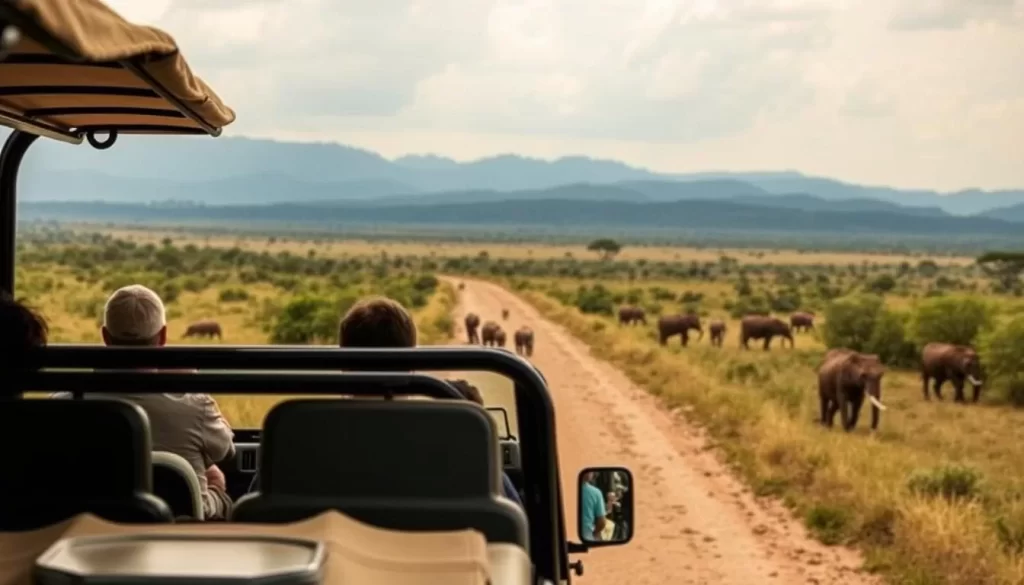
3-Day Exploration Tour
A 3-day exploration tour is an excellent way to get a taste of what Sibiloi National Park has to offer. This tour typically includes a visit to the Koobi Fora Museum, a boat safari on Lake Turkana, and a game drive to spot the park’s diverse wildlife.
The tour begins with a guided visit to the Koobi Fora Museum, where you can learn about the region’s rich archaeological history. The following day, you’ll embark on a boat safari on Lake Turkana, known for its large population of Nile crocodiles.
5-Day Comprehensive Experience
For a more immersive experience, consider the 5-day comprehensive tour. This extended itinerary allows you to explore the park’s less visited areas, including the petrified forest and Mount Sibiloi.
You’ll have the opportunity to hike Mount Sibiloi, visit the ancient cedar forest remains, and enjoy a leisurely boat ride on Lake Turkana. The tour also includes a cultural visit to a local community, providing insight into the traditional ways of life in northern Kenya.
Combining Sibiloi with Other Northern Kenya Destinations
Sibiloi National Park can be combined with other northern Kenya destinations to create a more extensive and varied itinerary. Consider visiting the western shore of Lake Turkana, the Chalbi Desert, or Mount Kulal to add more depth to your adventure.
A longer circuit might include Marsabit National Park, the Matthews Range, or Samburu National Reserve. These destinations offer a range of experiences, from wildlife viewing to cultural visits and outdoor adventures.
When planning a combined itinerary, consider the logistical considerations, including transportation options, travel times, and accommodation planning. The thematic connections between these destinations create a cohesive journey through Kenya’s dramatic northern frontier.
Conclusion: Why Sibiloi National Park Should Be on Your Kenya Bucket List
If you’re looking for a truly immersive experience in Kenya, Sibiloi National Park should be on your bucket list. This UNESCO World Heritage Site offers a unique blend of archaeological significance, natural beauty, and wildlife that is hard to find elsewhere.
Sibiloi National Park is more than just a safari destination; it’s an opportunity to walk in the footsteps of human ancestors millions of years ago. The park’s historical significance is unparalleled, with fossil beds and prehistoric discoveries that have shaped our understanding of human evolution over millions of years. As you safari through the park, you’ll encounter remarkable wildlife, including one of the world’s largest crocodile populations.
One of the advantages of visiting Sibiloi is that it’s a less-touristed destination, allowing for authentic wilderness experiences and personal connections with local cultures. This park represents a different side of Kenya, showcasing the country’s diversity of landscapes and experiences beyond the famous savanna parks. When you tour Kenya, including Sibiloi National Park in your itinerary will provide you with a more nuanced understanding of the country’s natural and cultural heritage.
While reaching Sibiloi National Park can be challenging due to its remote location, the rewards far outweigh the effort. For travelers seeking something truly special, this park is an unforgettable experience. By visiting Sibiloi, you’re not only creating memories but also contributing to the preservation of this extraordinary site through sustainable tourism.
In conclusion, Sibiloi National Park is a must-visit destination for anyone looking for a unique adventure. With its rich history, diverse wildlife, and stunning landscapes, it offers an experience that is both enriching and exhilarating. So, include Sibiloi in your Kenya travel plans and discover the wonders of this incredible national park.
The above is subject to change.
Check back often to TRAVEL.COM for the latest travel tips and deals.
